New Exhibit Celebrates 150th Anniversary of Salt Lake Tabernacle Organ
Contributed By R. Scott Lloyd, Church News staff writer
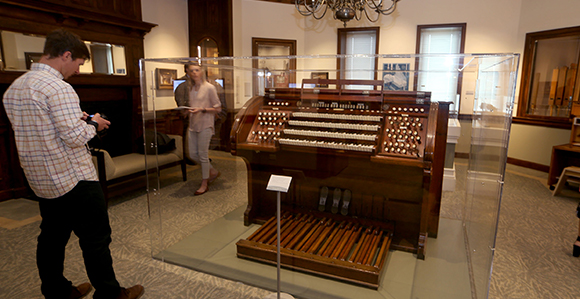
A Kimball organ dating back to the early 1900s is on display at an exhibit commemorating the 150th anniversary of the Salt Lake Tabernacle organ at the Church History Museum in Salt Lake City on Friday, May 19, 2017.
Article Highlights
- The new exhibit at the Church History Museum highlights this world-famous instrument.
- The exhibit will remain open through April 2018.
“Those of us who regularly play the Tabernacle organ have a keen sense of the sacrifice and ingenuity of the pioneers, as well as the sacrifices of so many individuals that have been made over the past 150 years and that have contributed to the fame of the organ and the choir.” —Richard Elliott, Tabernacle organist
Related Links
The world-famous Salt Lake Tabernacle organ has a landmark birthday this year, and the Church History Museum is celebrating with a new exhibit.
A history of music
It was 150 years ago at the 1867 October general conference that the as-yet-unfinished organ made its public debut.
Since then, the larger pipes that make up its façade have become a familiar sight worldwide, an “iconic backdrop for meetings and events broadcast throughout the world,” as one of the exhibit titles characterizes it.
The museum exhibit opened May 19 and will continue through April of next year.
The instrument has grown and evolved greatly over the years as its fame has increased. The exhibit highlights the organ’s history in artifacts, artwork, and displays.
Details of the exhibit
Entering the room on the museum’s second level, where the exhibit is contained, one is immediately drawn to the organ console in the center.
That console was used from 1901 to 1915. Its relatively short lifespan was not due to it being worn out from frequent use, as one might suppose, but just the opposite.
“In those days, it wasn’t used a lot,” said Harry Cross, a registrar at the museum and, with an academic background in organ, the creative consultant for the exhibit. “The reason it only lasted 15 years is it deteriorated from lack of use. The best way to keep an instrument like an organ operational is to use it. It’s just like your body—if you don’t use your limbs, you’ll lose the use of them. It’s the same with the console: Parts deteriorate or dry out if they’re not used.”
Another dominant feature in the exhibit is a wall-size timeline covering 1867 forward. Landmark events in the organ’s lifetime are juxtaposed with events in American or world history that occurred at or near the same time.
For example, the wood casing around the organ was completed and a third manual added in 1869, the year the transcontinental railroad was completed at Promontory Summit, Utah. The Columbia Phonograph Co. created the first recording of the Tabernacle Choir and organ in 1910, the year the Boy Scouts of America was founded. And Schoenstein & Co. undertook a renovation of the organ in 1984, the year Apple debuted the Macintosh personal computer.
The exhibit features a small demonstration organ—a “mechanical action instrument”—built in 1990 to show occasional visitors to the Tabernacle how the organ functioned prior to 1901, when the Kimball Organ Co. rebuilt the organ and included the freestanding console now displayed at the center of the exhibit.
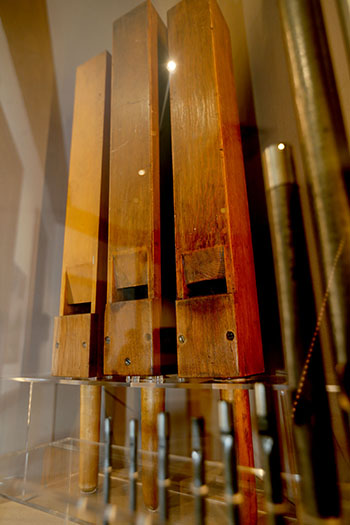
Salt Lake Tabernacle organ pipes that were used between 1867 and 1948 are on display at an exhibit commemorating the 150th anniversary of the Salt Lake Tabernacle organ at the Church History Museum in Salt Lake City on Friday, May 19, 2017. Photo by Laura Seitz, Deseret News.
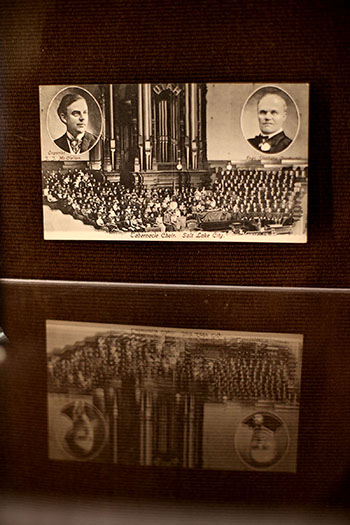
Postcards that highlight the Salt Lake Tabernacle organ are on display at an exhibit commemorating the 150th anniversary of the Salt Lake Tabernacle organ at the Church History Museum in Salt Lake City on Friday, May 19, 2017. Photo by Laura Seitz, Deseret News.
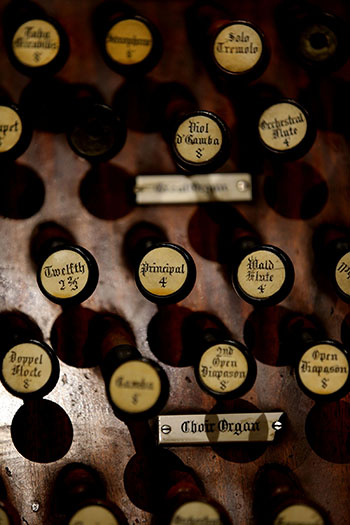
A Kimball organ dating back to the early 1900s is on display at an exhibit commemorating the 150th anniversary of the Salt Lake Tabernacle organ at the Church History Museum in Salt Lake City on Friday, May 19, 2017. Photo by Laura Seitz, Deseret News.
“You have direct linkage between the keys on the keyboard and the pipes,” Cross explained, demonstrating the action. “You have trackers and roller bars. When you push the key down, you can follow the action up to the roller bar, where it pulls a valve down.” That releases air from a reservoir into the organ pipe.
The air comes from the rear of the instrument, where a bellows is manually pumped to fill the reservoir, which must be continually replenished as the keyboard/pipe mechanisms draw the air from it.
Growing interest
Originally planned to be smaller, the exhibit has grown both in content and in the interest it has engendered, said artifacts curator Alan Morrell. “It was fun to have things just show up, and it was a fun creative process to pull this off.”
Cross, the creative consultant, said the idea emerged when word came that a regional convention of the American Guild of Organists will meet June 11–15 in Salt Lake City. As Cross brought that up in a meeting with Tabernacle staff, organist Richard Elliott mentioned this being the 150th anniversary of the Tabernacle organ.
“Do you think the museum could do an exhibit?” the organist asked.
Cross presented a proposal to museum and Church leaders, who enthusiastically approved the idea.
“So all of a sudden, we were on a scramble, because we should have started preparing this almost a year ago,” Cross said. As much as possible, items were used that belong to the museum, but some have been borrowed from people involved with the Tabernacle Choir.
Going back to the organ’s beginning, the exhibit features a saw that, according to family tradition, Joseph Ridges used to build the original organ.
On display are wood and metal pipes used in the organ between 1867 and 1948; thousands of such pipes of various sizes and shapes are situated behind the tall, gold-leafed pipes that the public sees from the benches of the Tabernacle.
Personal items that belonged to famous Tabernacle organists of yesteryear are displayed, such as Frank Asper’s organ shoes, John Longhurst’s cufflinks, Katherine Romney Stewart’s purse, Robert Cundick’s glasses, and musical scores written by Joseph J. Daynes and Robert Cundick.
A wooden and ivory cane on display was made from one of the stops of the original Ridges organ.
An RCA velocity microphone used for Tabernacle Choir broadcasts during the 1930s is displayed in the exhibit.
More than 20 musicians have held the title of Salt Lake Tabernacle organist or assistant organist. They are listed in the exhibit.
A group photo features the organists and assistant organists serving today: Andrew Unsworth (2007), Linda Margetts (1984), Richard Elliott (1991), Bonnie Goodliffe (1979), and Clay Christiansen (1982).
An interactive kiosk has videos featuring performances and narrative from some of the organists.
Tabernacle organists on the exhibit
In response to inquiries from the Church News, two of the organists gave comments:
“We Tabernacle organists sometimes refer to the Tabernacle organ as having a ‘signature sound,’” Andrew Unsworth said.
“There are certain colors of the Tabernacle organ—such the sounds we use for ‘As the Dew from Heaven Distilling’ at the end of the choir’s broadcast, the lush string choruses of the instrument, and the noble reed choruses—that are quintessentially ‘Tabernacle organ.’ When I hear them, I know right away what instrument I’m listening to.
“Another thing that makes the Tabernacle organ special is that it is so impeccably maintained. I’ve never played another organ that is kept in such consistently good condition.”
Richard Elliott remarked, “The Salt Lake Tabernacle organ has a remarkable history that is intertwined with two epic stories: that of the pioneers in early Utah and that of the coming forth of the Church out of relative obscurity to becoming a worldwide Church, which is mirrored by the history of the Mormon Tabernacle Choir. Those of us who regularly play the Tabernacle organ have a keen sense of the sacrifice and ingenuity of the pioneers, as well as the sacrifices of so many individuals that have been made over the past 150 years and that have contributed to the fame of the organ and the choir.
“Aside from that, the Tabernacle organ is one of the most refined and lovely organs I have ever played. There isn’t a single pipe that sounds ugly or out of place. The acoustics are the ideal blend of warmth, bloom, and clarity. It is certainly special because of its iconic status as one of the world’s most famous instruments. And we are very fortunate that it is without question the best-maintained pipe organ on the planet.”
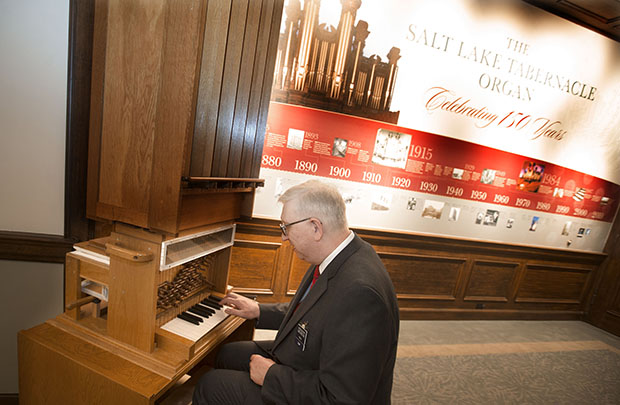
Harry Cross, creative consultant of an exhibit commemorating the 150th anniversary of the Salt Lake Tabernacle organ, plays an organ in the exhibit at the Church History Museum in Salt Lake City on Friday, May 19, 2017. Photo by Laura Seitz, Deseret News.
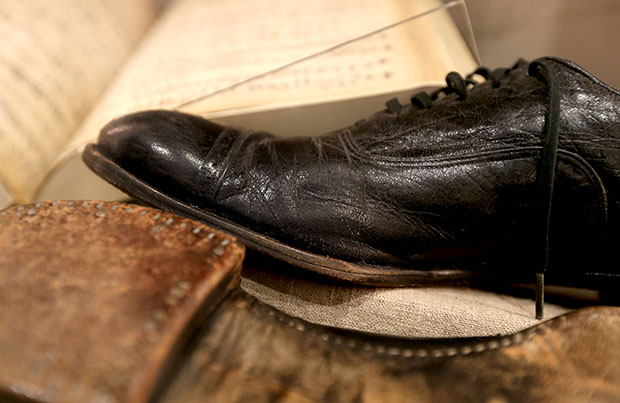
Organ shoes are on display at an exhibit commemorating the 150th anniversary of the Salt Lake Tabernacle organ at the Church History Museum in Salt Lake City on Friday, May 19, 2017. Photo by Laura Seitz, Deseret News.
